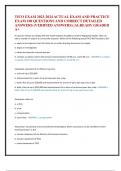Resume
Volledige Samenvatting van het vak European and international Justice, Home affaires and Security policy (Geslaagd in eerste zit)
- Établissement
- Universiteit Gent (UGent)
Vak: European and international Justice, Home affaires and Security policy Professor(en): Gert Vermeulen / Wendy De Bondt Academiejaar: Inhoud samenvatting: Slides + notities + handboek Omschrijving: Volledige, overzichtelijke samenvatting in het engels (schematisch) Behaald punt: 15 / 20 (in...
[Montrer plus]












